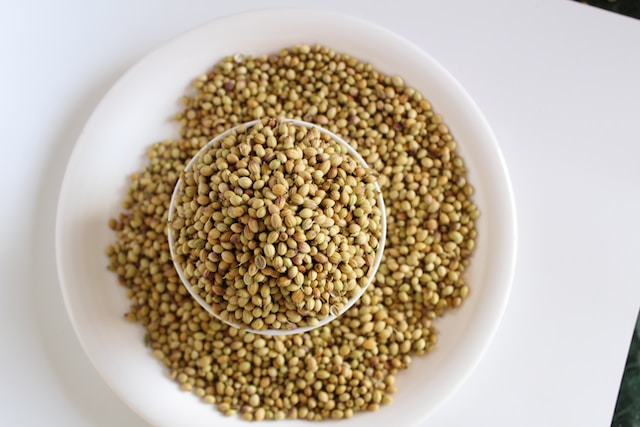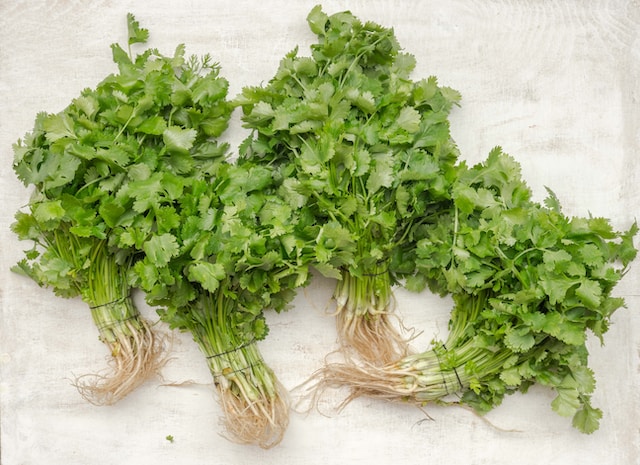Table of Contents
Step-by-Step Guide to Growing Coriander From Seed

Wondering how to grow coriander from seed? It’s quite easy! Growing coriander from seed is a great way to add a delicious, fresh flavor to your cooking. With just a few simple steps, you can have a steady supply of this fragrant herb in your kitchen. Here’s a step-by-step guide to get you started with your new herb garden:
Step 1: Choose the right seeds. Look for coriander seeds that are dark brown in color and have a smooth, glossy texture. Avoid any that are cracked or discolored.
Step 2: Prepare the soil. Coriander prefers a light, well-draining soil. If your soil is heavy, mix in some compost or peat moss to lighten it up.
Step 3: Plant the seeds. Plant the seeds about 1/4 inch deep and about 2 inches apart. Water the soil lightly and keep it moist until the seeds germinate.
Step 4: Thin the seedlings. Once the seedlings have grown to about 2 inches tall, thin them out so that they are spaced about 4 inches apart. Don’t discard the ones you remove, use them in your next recipe!
Step 5: Water and fertilize. Keep the soil moist and fertilize the plants every few weeks with a balanced fertilizer.
Step 6: Harvest the leaves. When the leaves are about 4 inches long, you can start harvesting them. Cut the leaves off at the base of the plant and use them fresh or dried.
That’s it! With just a few simple steps, you can have a steady supply of fresh coriander in your kitchen. Enjoy! And if you want to make sure you get the most from your harvest, keep reading while I cover some tips on boosting your yield.

Photo by Tomasz Olszewski on Unsplash
Tips for Maximizing Coriander Yields When Growing From Seed
1. Start with high-quality seeds: Make sure you’re starting with the best quality seeds you can find. Look for organic, non-GMO seeds that are specifically labeled for growing coriander. The seeds you get from the spices section of your grocery store are not likely to germinate.
2. Plant in the right season: Coriander is a cool-season crop, so it’s best to plant it in the spring or fall. Planting in the summer can lead to bolting, which is when the plant goes to seed prematurely. If you start in the cool season and you plant survives into summer, use this opportunity to harvest the seeds!
3. Plant in well-draining soil: Coriander needs soil that drains well and is slightly acidic. If your soil is too heavy, add some compost or peat moss to lighten it up. Adding compost or even some spent coffee grounds can help condition the soil.
4. Give it plenty of sun: Coriander needs at least 6 hours of direct sunlight each day. If you’re planting in the spring or fall, make sure to choose a spot that gets plenty of sun. If you’re growing indoors, choose a south-facing window.
5. Water regularly: Coriander needs to be kept consistently moist, but not soggy. Water it deeply once or twice a week, depending on the weather. Keep a close eye on your herbs and if they seem droopy, check the soil to see if it’s time to water again.
6. Thin out the seedlings: Once your seedlings have grown to about 4 inches tall, thin them out so that they’re spaced about 6 inches apart. This will give them enough room to grow deep roots and produce more coriander.
7. Harvest regularly: Coriander is ready to harvest when the leaves are a bright green color. Harvest the leaves regularly to encourage more growth and maximize your yields. You can keep harvesting from the same plant all season, as long as you do so sparingly.
How to Choose the Right Soil for Growing Coriander From Seed
When it comes to growing coriander from seed, choosing the right soil is essential for success. The good news is that coriander is a fairly easy plant to grow, and it doesn’t require any special soil. However, there are a few things to keep in mind when selecting the right soil mix from the hardware store for your coriander.
First, make sure the soil is well-draining. Coriander doesn’t like to sit in water, so it’s important to choose a soil that won’t become waterlogged. A good way to test this is to take a handful of soil and squeeze it in your hand. If it holds its shape, it’s too dense and won’t drain well. If it crumbles easily, it’s a good sign that it will drain well.
Second, make sure the soil is nutrient-rich. Coriander needs plenty of nutrients to grow, so it’s important to choose a soil that is high in organic matter. Compost, manure, and other organic materials are great for adding nutrients to the soil.
Finally, make sure the soil is slightly acidic. Coriander prefers a slightly acidic soil, so it’s important to check the pH level of the soil before planting. A pH level between 6.0 and 6.5 is ideal for coriander. You can buy a test kit online if you’re not sure about your local soil conditions.
By following these tips, you can be sure to choose the right soil for growing coriander from seed. With the right soil, you’ll be well on your way to a successful harvest! Just make sure you keep reading so you can avoid some of these common issues people run into growing coriander.
Common Mistakes to Avoid When Growing Coriander From Seed
Growing coriander from seed can be a rewarding experience, but there are some common mistakes to avoid if you want to get the best results. Here are some tips to help you get the most out of your coriander crop:
1. Don’t plant too early. Coriander is a cool-season crop, so it’s best to wait until the soil has warmed up before planting. Planting too early can lead to poor germination and slow growth.
2. Don’t plant too deep. Coriander seeds should be planted no more than 1/4 inch deep. Planting them too deep can lead to poor germination and slow growth.
3. Don’t over-water. Coriander likes moist soil, but it doesn’t like to be waterlogged. Over-watering can lead to root rot and other problems.
4. Don’t forget to thin. Once your coriander plants have germinated, you should thin them out to give them room to grow. If you don’t thin them, they will compete for resources and won’t grow as well.
5. Don’t forget to fertilize. Coriander needs a steady supply of nutrients to grow well. Make sure to fertilize your plants regularly to ensure they get the nutrients they need.
By following these tips, you can avoid common mistakes and get the most out of your coriander crop. Good luck and be sure to drop your favorite recipe that includes coriander in the comments below!


